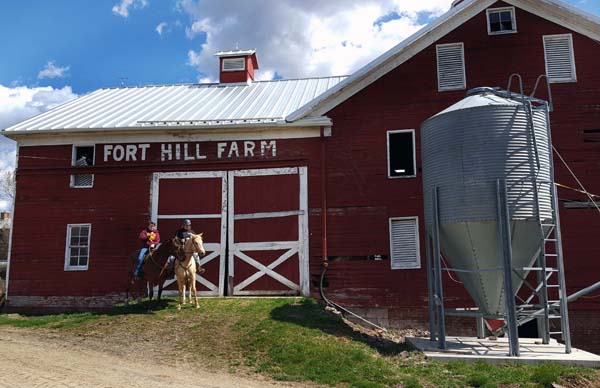Fort Hill: Seven Generations of Farming
By Jeffrey S. Smith

The family still does much work at Fort Hill Farm on horseback. Pictured here are Sarah Page (left) and a friend. Sarah, a seventh-generation
descendant of farm founder James Sloan Sr., is studying meat sciences at The Ohio State University so she can keep up the farming heritage at Fort Hill. Photo by Jeffrey S. Smith.
Situated among the pastoral, grazing lands and rolling hills of Mineral County, Fort Hill Farm has been an agricultural workhorse since the 19th century. The house and 240 of the original 5,000 acres of farmland were listed in the National Register of Historic Places in 1997. The house was built by James “Grandpappy” Sloan, Sr. (1812-1907), in the 1800s. Since that time, the farm has been managed by seven generations of descendants, including the current owners—members of the Bonar, Hannah, and Page families—who are keeping the farming operation in good stead more than 160 years later.
Grandpappy Sloan laid out and divided up the land for Patterson Creek Manor in 1834. He and his living brothers—John, George, Thomas, and Richard—became joint owners of the property. According to family folklore, the Sloan brothers (all bachelors) drew straws to see which one would find a wife to help out their mother, Charlotte, around the family home. Grandpappy drew the short straw and married Magdalena Arnold (1810-1863) on January 6, 1835. They moved out of their stone home (the Sloan-Parker House) and began constructing Fort Hill, which was completed around 1853.
An October 1853 receipt details a request for the manufacture of 173,000 bricks on Patterson’s Creek. The solid, masonry, Greek Revival home featured fashionable finishes reminiscent of the 19th century: a symmetrical façade, a Neoclassical-inspired front porch (altered from a two-story portico), front entry sidelights, and transoms. Aside from the introduction of modern necessities and conveniences, the Fort Hill home remains virtually unaltered from its mid-19th-century appearance.
The farm and house have been passed down through the generations. “Grandpappy” Sloan presided over a household of children, grandchildren, orphaned great-grandchildren, and two unmarried sisters. When he died, the farm passed on to his three living granddaughters: Magdalena Arnold Sloan, Helen Mary Sloan, and Jane Pierce Sloan.
You can read the rest of this article in this issue of Goldenseal,In 1926, Cornelia Sarah Harmison, one of Grandpappy’s great-granddaughters, married Clyde Bonar, a former Mineral County Extension agent. Not long afterward, the Bonars moved to Fort Hill and managed the farm for the Sloan sisters. In 1935, when Jane Pierce Sloan—the last of Grandpappy’s granddaughters—passed, she willed one half of the farm to Clyde and Cornelia and the other half—including the house, barns, and buildings—to Clyde and Cornelia’s five-year old daughter Mary Alice (who passed away in 2017 at age 87).
Clyde introduced several innovative farm conservation and land management practices to the Burlington area and showcased the prize-winning Aberdeen-Angus cattle herd at the West Virginia State Forest Festival in Elkins. The Bonars maintained a daily account of what occurred on the farm. Clyde also kept meticulous records of resource / utility consumption, crop output, and animal husbandry / productivity during his tenure at Fort Hill Farm.
available in bookstores, libraries or direct from Goldenseal.